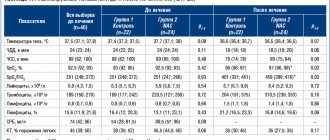Nimesil granules for the preparation of suspension for oral administration 100 mg sachets 9 pcs. in Moscow
Undesirable side effects can be minimized by using the minimum effective dose of the drug for the shortest possible short course.
Nimesulide should be used with caution in patients with a history of gastrointestinal diseases (ulcerative colitis, Crohn's disease), since exacerbation of these diseases is possible.
The risk of gastrointestinal bleeding, ulceration or perforation of an ulcer increases with increasing dose of NSAIDs in patients with a history of ulcers, especially those complicated by bleeding or perforation, and in elderly patients, so treatment should be started at the lowest possible dose. Patients receiving drugs that reduce blood clotting or inhibit platelet aggregation also have an increased risk of gastrointestinal bleeding. If gastrointestinal bleeding or ulcers occur in patients taking nimesulide, treatment with the drug should be discontinued.
Since nimesulide is partially excreted by the kidneys, the dose for patients with impaired renal function should be reduced, depending on the level of urination.
There is evidence of rare cases of liver reactions. If signs of liver damage appear (itching, yellowing of the skin, nausea, vomiting, abdominal pain, dark urine, increased activity of liver transaminases), you should stop taking the drug and consult your doctor.
Despite the rarity of visual impairment in patients taking nimesulide concomitantly with other NSAIDs, treatment should be stopped immediately. If any visual disturbance occurs, the patient should be examined by an ophthalmologist.
Nimesulide can cause fluid retention in tissues, so patients with high blood pressure and cardiac dysfunction should use nimesulide with extreme caution.
In patients with renal or heart failure, nimesulide should be used with caution, as renal function may deteriorate. If the condition worsens, treatment with nimesulide should be discontinued.
Clinical studies and epidemiological data suggest that NSAIDs, especially at high doses and with long-term use, may lead to a small risk of myocardial infarction or stroke. There is insufficient data to exclude the risk of such events when using nimesulide.
The drug contains sucrose, which should be taken into account by patients suffering from diabetes (0.15-0.18 XE per 100 mg of the drug) and those on a low-calorie diet. Nimesulide is not recommended for use in patients with rare hereditary diseases such as fructose intolerance, glucose-galactose malabsorption or sucrase-isomaltase deficiency.
If signs of a “cold” or acute respiratory viral infection occur during treatment with nimesulide, the drug should be discontinued.
Nimesulide should not be used simultaneously with other NSAIDs.
Nimesulide can change the properties of platelets, so caution must be exercised when using the drug in people with hemorrhagic diathesis, however, the drug does not replace the preventive effect of acetylsalicylic acid in cardiovascular diseases.
Elderly patients are particularly susceptible to adverse reactions to NSAIDs, incl. the occurrence of gastrointestinal bleeding and perforations that threaten the patient’s life, deterioration of kidney, liver and heart function. When taking nimesulide for this category of patients, proper clinical monitoring is necessary.
Like other drugs of the NSAID class that inhibit prostaglandin synthesis, nimesulide can adversely affect pregnancy and/or embryo development and can lead to premature closure of the ductus arteriosus, hypertension in the pulmonary artery system, impaired renal function, which can lead to renal failure with oligohydramnios, increased risk of bleeding, decreased contractility of the uterus, and the occurrence of peripheral edema. In this regard, nimesulide is contraindicated during pregnancy and lactation. The use of nimesulide may adversely affect female fertility and is not recommended for women planning pregnancy. When planning a pregnancy, consultation with your doctor is necessary.
There is evidence of the occurrence in rare cases of skin reactions (such as exfoliative dermatitis, Stevens-Johnson syndrome, toxic epidermal necrolysis) to nimesulide as well as to other NSAIDs. At the first signs of a skin rash, damage to the mucous membranes or other signs of an allergic reaction, nimesulide should be discontinued.
Impact on the ability to drive vehicles and machinery
The effect of nimesulide on the ability to drive vehicles and operate machinery has not been studied, therefore, during the treatment period, caution should be exercised when driving vehicles and engaging in potentially hazardous activities that require increased concentration and speed of psychomotor reactions.
Use of Nimesil powder: indications and contraindications
The medicine is used to suppress pain, inflammation, and associated symptomatic manifestations. In the instructions for use, the manufacturer recommends taking Nimesil for the following indicators:
- for pain accompanying osteoarthritis;
- painful sensations arising from injuries, inflammation in the joint capsule and tendons;
- algodismenorrhea.
The list of contraindications for the use of Nimesil is presented:
- bronchospasm, rhinitis, symptoms of urticaria that occur in response to taking NSAIDs or aspirin;
- performed coronary artery bypass surgery, therapy with hepatotoxic medications;
- inflammatory pathologies of the intestinal tract;
- elevated temperature due to inflammatory and infectious pathologies;
- transition to the acute phase of the ulcer, spontaneous hemorrhages in the gastrointestinal tract;
- a combination of allergies to NSAIDs, nasal polyps and chronic inflammation of the respiratory tract;
- local hemorrhages;
- decompensated kidney or heart failure;
- disorders of blood clotting rate;
- potassium deficiency, liver pathologies;
- alcoholism, drug addiction;
- period of pregnancy or breastfeeding;
- children under twelve years of age.
Particular caution when taking is necessary for patients:
- with severe form of non-insulin-dependent diabetes;
- hypertension or ischemia;
- AHF, dyslipidemia;
- lesions of peripheral arteries;
- ulcers, somatic diseases in the period of decompensation.
The medication requires medical supervision with prolonged use of NSAIDs, oral glucocorticosteroids, and antiplatelet agents. Problems with therapy can be caused by smoking and simultaneous treatment with drugs that slow down the rate of blood clotting.
Methods and dosages in the instructions for use of Nimesil
The granular product is diluted in half a glass of water, the finished substance should be used immediately. The drug is taken orally, 1 sachet after meals, twice a day. Therapeutic manipulations should not exceed 2 weeks. To prevent the development of adverse reactions, the medication is prescribed in minimal effective dosages.
The instructions for use of Nimesil do not contain any special instructions for the treatment of children - in the period from 12 to 18 years, therapy is carried out at adult dosages. If the patient has a history of kidney disease, then the standard amount and frequency of use of the solution remains unchanged.
In old age, the characteristics of the body are taken into account; all changes in the therapy recommended by the manufacturer are carried out on the recommendation of a doctor. The specialist is based on the compatibility of the drug with other medications.
Doctors do not recommend using Nemisil for minor attacks of headache or without a prescription from a local physician. The drug is not suitable for continuous use and can cause serious adverse reactions, including anaphylactic shock and coma. The appearance of unusual clinical signs requires immediate contact with a local physician.
Possible adverse reactions to Nimesil and overdose
Non-standard effects during treatment appear:
- allergies - with increased sweating, rashes, itching, erythema, urticaria, dermatitis, Lyell and Stevens-Johnson syndrome, Quincke's edema;
- problems with the hematopoietic system - anemic conditions, insufficient levels of platelets, leukocytes, red blood cells, hemorrhagic syndrome, thrombocytopenic purpura, increased number of eosinophils;
- visual and nervous disorders - panic attacks, vestibular dysfunction, cephalalgia, poor sleep with nightmares, non-inflammatory brain damage, unreasonable anxiety, drowsiness, decreased visual acuity;
- dysfunction of the circulatory system - rapid heartbeat, arterial hypertension, hot flashes, changes in blood pressure;
- pathologies of the digestive tract - dyspeptic disorders, gastritis, increased gas formation, painful sensations in the epigastric region, ulcers and perforation of the gastrointestinal tract, hepatitis, icteric discoloration of the skin, an increase in the number of liver enzymes.
When adverse reactions occur in the respiratory department, shortness of breath is observed. In other cases, there is a decrease in body temperature, hematuria, problems with urination, and asthenic syndrome.
Symptoms of an overdose of Nimesil include vomiting, apathy, nausea and drowsiness. In difficult cases, spontaneous bleeding develops in the gastrointestinal tract, sometimes there is an increase in blood pressure, acute kidney dysfunction, breathing problems, anaphylaxis, and coma.
To relieve the clinical manifestations of an overdose, symptomatic treatment is used, with gastric lavage, taking activated charcoal (1 tablet per 10 kg of weight), and an osmotic laxative. It is imperative to monitor the functionality of the liver and kidneys.
Nimesil gran d/oral suspension 100 mg cor 2 g x30
Trade name: Nimesil International name: Nimesulide
Release form: granules for the preparation of suspension for oral administration 100 mg (three-layer sachets)
Composition: nimesulide 100 mg - 2 g.
Pharmacological group: NSAID (non-steroidal anti-inflammatory drug)
Pharmacological group according to ATK: M01AX17 (Nimesulide)
Pharmacological action: antiplatelet, antipyretic, NSAID, anti-inflammatory, selective cyclooxygenase II blocker, analgesic,
Indications: Rheumatism, ankylosing spondylitis (Bechterew's disease), osteoarthritis, synovitis, tendinitis, tendovaginitis, bursitis, pain syndrome (algomenorrhea, post-traumatic pain), febrile syndrome in infectious and inflammatory diseases, pain in the spine, neuralgia, myalgia, traumatic inflammation of soft tissues and musculoskeletal system.
Dosage regimen: Orally, 100 mg (1 tablet), after meals, or dissolving the contents of 1 sachet of granulate in 80-100 ml of water, 2 times a day. The prepared solution cannot be stored. Children over 2 years of age are prescribed as a suspension at a dose of 1.5 mg/kg 2-3 times a day. The maximum daily dose for children is 5 mg/kg. Adolescents weighing over 40 kg - 100 mg (10 ml) no more than 2 times a day.
Contraindications: Hypersensitivity, erosive and ulcerative lesions of the gastrointestinal tract (in the acute phase), bleeding from the gastrointestinal tract, aspirin-induced asthma, liver failure, renal failure (creatinine clearance less than 30 ml/min), pregnancy (III trimester), lactation period, children under 12 years (tablets), children up to 2 years (suspension for oral administration).
Side effects: Heartburn, nausea, vomiting, diarrhea, gastralgia, ulceration of the gastrointestinal mucosa, headache, dizziness, fluid retention, allergic reactions (skin rash, anaphylactic shock), thrombocytopenia, leukopenia, anemia, agranulocytosis, increased activity of “liver” transaminases , prolongation of bleeding time, hematuria.
Pharmacodynamics: NSAIDs have anti-inflammatory, analgesic, antipyretic and antiplatelet effects. Unlike other NSAIDs, it selectively suppresses COX2, inhibits Pg synthesis at the site of inflammation, and has a less pronounced inhibitory effect on COX1 (less likely to cause side effects associated with inhibition of Pg synthesis in healthy tissues).
Pharmacokinetics: Absorption when taken orally is high (food intake reduces the rate of absorption without affecting its degree). TCmax - 1.5-2.5 hours. Communication with plasma proteins - 95%, with erythrocytes - 2%, with lipoproteins - 1%, with acidic alpha1-glycoproteins - 1%. Changing the dose does not affect the degree of binding. Cmax - 3.5-6.5 mg/l. Volume of distribution - 0.19-0.35 l/kg. Penetrates into the tissues of the female genital organs, where after a single dose its concentration is about 40% of the concentration in plasma. Penetrates well into the acidic environment of the inflammation site (40%) and synovial fluid (43%). Easily penetrates histohematic barriers. Metabolized in the liver by tissue monooxygenases. The main metabolite, 4-hydroxynimesulide (25%), has similar pharmacological activity, but due to a decrease in molecular size, it is able to quickly diffuse through the hydrophobic COX2 channel to the active binding site of the methyl group. 4-Hydroxynimesulide is a water-soluble compound, the elimination of which does not require glutathione and conjugation reactions of phase II metabolism (sulfation, glucuronidation, etc.). T1/2 of nimesulide - 1.56-4.95 hours, 4-hydroxynimesulide - 2.89-4.78 hours. 4-Hydroxynimesulide is excreted by the kidneys (65%) and bile (35%), and undergoes enterohepatic recirculation.
Special instructions: With long-term use, systematic monitoring of renal function is necessary. Carefully. Arterial hypertension, CHF, diabetes mellitus type 2. Category of effect on the fetus. C
Interaction: Pharmacokinetic interaction - at the level of binding to plasma proteins (increases the concentration of drugs that compete for binding to plasma proteins). Myelotoxic drugs increase the manifestations of hematotoxicity of the drug.
Dispensed from pharmacies: Dispensed by prescription.
Drug registration number: P No. 011439/01
Date of registration (re-registration) of the drug: 09.12.2005


